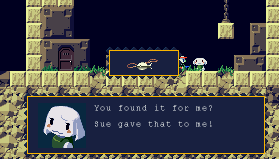ThruSpace is an action-puzzle game in the vein of Tetris, or rather it's often overlooked successor,
Welltris. The object is to guide 3D polyominoes (called keydrons by the game) through gaps in walls that block the hallway the pieces are being propelled through. Keydrons may be flipped, twisted, turned and shifted in all directions and the gaps are designed to require all of these manipulations to pass the walls. According to the promotional information, the game features three different modes of play and you can earn higher scores by collecting crystals within gaps, performing tricks (covering all squares of a gap with the keydron's shadow) and accelerating toward the corridor more quickly. These scores are tallied on a global leaderboard.

Prior interest: low
That screenshot pretty much tells the story. WiiWare has a surplus of interesting and stylish puzzlers including, of course, Tetris, Dr. Mario and the Art Style series. Because of it's size limitation, the service has plenty of graphically simple puzzle games. It's just a lot easier to squeeze this sort of game into a handful of blocks
1 than, say, an RPG. In order to stand out from the crowd, a game needs to do something unique. Groovin' Blocks incorporates music into the structure of gameplay, for instance. ThruSpace has... well it has a demo now. Honestly, I wouldn't have taken a second look at it otherwise.
Odds of purchase: low
So the demo turns out to be a tutorial followed by a small taste of the timed mode with two keydrons. In my first run-through I used the NES-style Wiimote controls, which don't fit into the brain very well. With any 3D world, it's hard to map the freedom of movement to any human understandable control scheme. Generally controls (both in real life applications and games) reduce the freedom of movement to some manageable amount. You don't, for instance, directly control every twist and turn of a 3D platforming character. Rather you control movement direction on a horizontal surface and have a jump (or similar) button to give your character a short vertical acceleration. It turns out controlling all possible movements (pitch, yaw, roll, and translations along the three axes) requires 12 distinct inputs. ThruSpace only allows acceleration in the direction of travel and not decceleration, so it requires just 11 inputs. But the Wiimote only has 10 inputs (including + and -, but not the power or Wii Menu buttons). So the control scheme simplifies the rotational movements to one direction, which means if you over-rotate you need to cycle through the other attitudes.
With the Nunchuk (and Classic Controller), all six rotations are possible and the buttons are mapped slightly better than with the Wiimote alone. Even so, as I explained when discussing And Yet It Moves, some of the rotation buttons are mapped the wrong way around from how I'm most comfortable. Unfortunately, the game does not allow rearranging the controls so I'm stuck doing a lot of trial and error to get the keydron lined up just so.
There are things to commend the game for: catchy music, appropriate sound, functional visuals, responsive controls (modulus rotational confusion), plenty of modes (apparently), interesting choices (to go for tricks, crystals or time, etc.), arcade-style accessibility and challenge, and all around high production values. But I feel the game falls short of its potential in many ways. More interesting visuals and better control configuration would have been welcome as I've already alluded. It seems like the tilt controls and/or pointer would have been useful and intuitive (see And Yet It Moves). But the game as presented by the demo lacks inspiration. Maybe the full game has it, but if so the demo fails to show us through a tedious tutorial and truncated timed mode.
Doing some research on this style of puzzle, I discovered Blockout, which was released in 1989. It's also very similar to ThruSpace in that the focus is on manipulating polyominoes in a 3D space. Unlike ThruSpace's racecourse analogy, Blockout works like a box filling exercise. Even so, I felt a sense of urgency in the earlier game. Perhaps the difference comes from the relative lack of consequences for sub-optimal play in ThruSpace—if you can make it through a gap, there's usually enough of time to play the next gap perfectly no matter how poorly you set yourself up. It makes me wonder how the demo would have come off if the game had a multiplayer race mode.
1 - ThruSpace almost seems like a metaphor for the WiiWare service itself. Apply clever transformations to get an object through a confined location.














